Abstract
Bacteria adsorbed in low numbers to alfalfa or clover root surfaces were counted after incubation of seedlings in mineral solution with very dilute inocula (less than 105 bacteria per ml) of an antibiotic-resistant strain under defined conditions. After specified washing, bacteria which remained adsorbed to roots were selectively quantitated by culturing the roots embedded in yeast extract-mannitol-antibiotic agar and counting the microcolonies along the root surface; the range was from about 1 bacterium per root (estimated as the most probable number) to 50 bacteria per cm of root length (by direct counting). This simple procedure can be used with any pair of small-rooted plant and antibiotic-resistant bacterium, requires bacterial concentrations comparable to those frequently found in soils, and yields macroscopic localization and distribution data for adsorbed bacteria over the root surface. The number of adsorbed bacteria was proportional to the size of the inoculum. One of every four Rhizobium meliloti cells adsorbed in very low numbers to alfalfa roots resulted in the formation of a nodule. Overall adsorption of various symbiotic and nonsymbiotic bacterial strains to alfalfa and clover roots did not reflect the specificities of these legumes for their respective microsymbionts, R. meliloti and R. trifolii.
Full text
PDF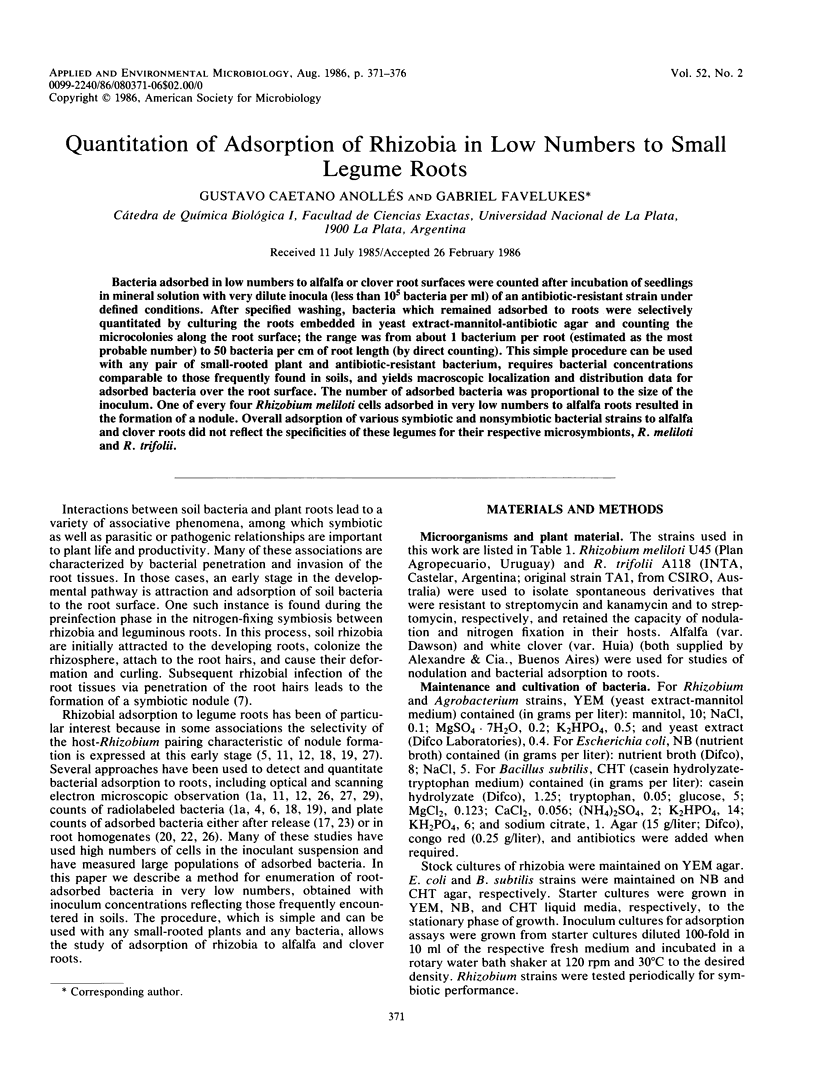

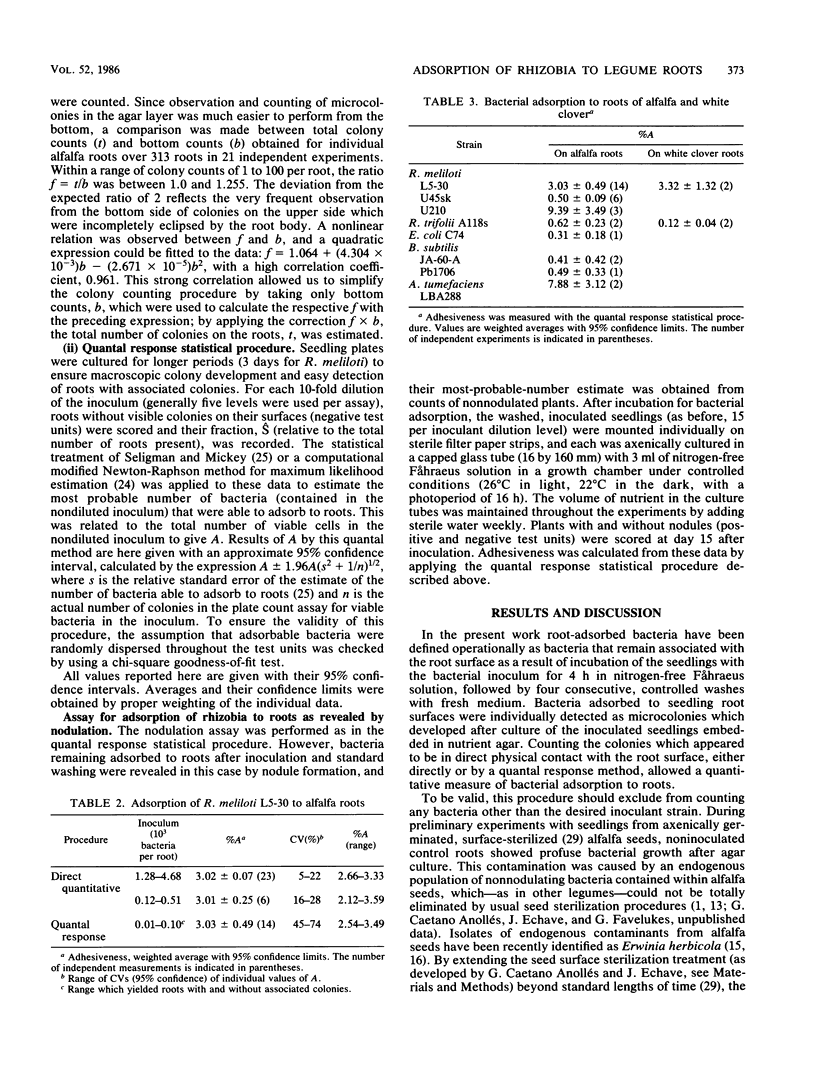
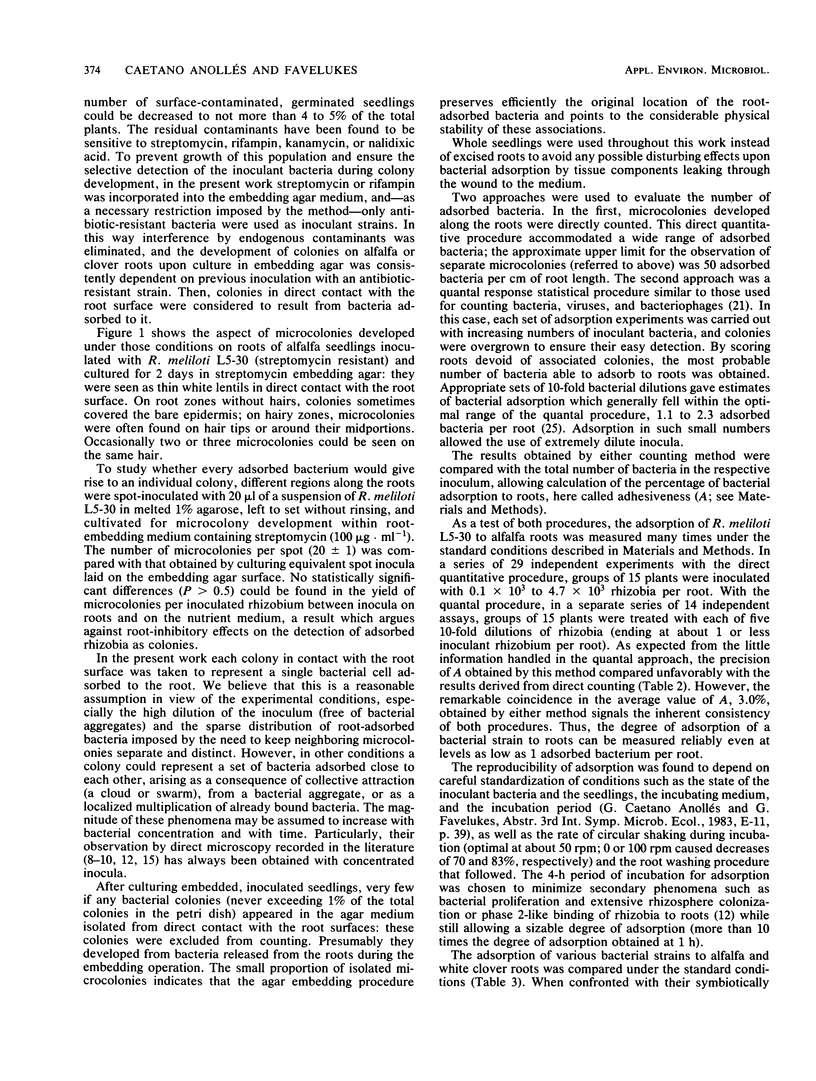
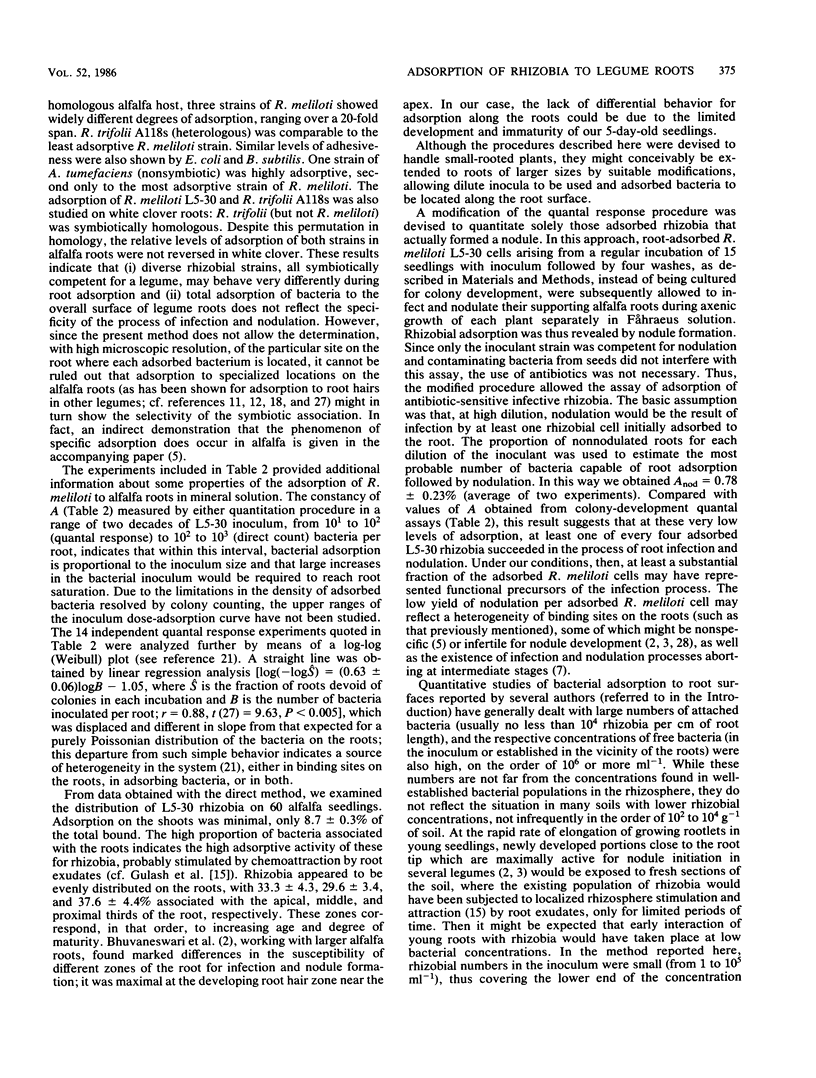
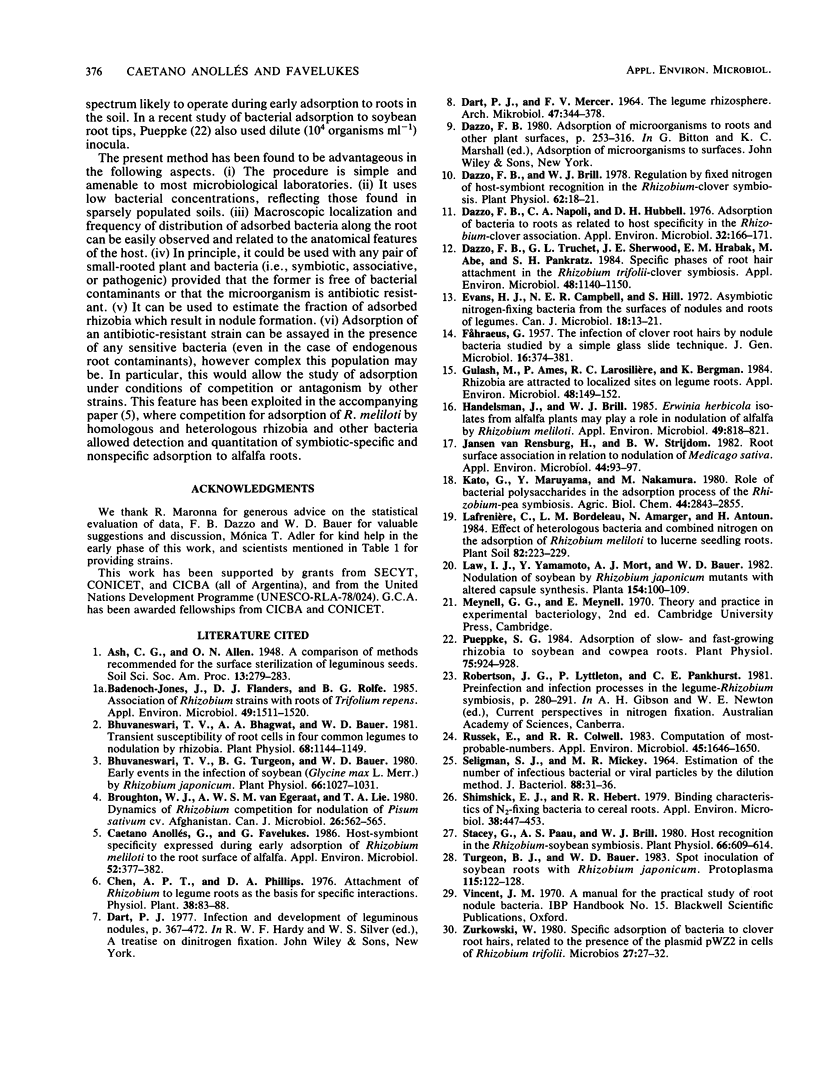
Images in this article
Selected References
These references are in PubMed. This may not be the complete list of references from this article.
- Badenoch-Jones J., Flanders D. J., Rolfe B. G. Association of Rhizobium Strains with Roots of Trifolium repens. Appl Environ Microbiol. 1985 Jun;49(6):1511–1520. doi: 10.1128/aem.49.6.1511-1520.1985. [DOI] [PMC free article] [PubMed] [Google Scholar]
- Bhuvaneswari T. V., Bhagwat A. A., Bauer W. D. Transient susceptibility of root cells in four common legumes to nodulation by rhizobia. Plant Physiol. 1981 Nov;68(5):1144–1149. doi: 10.1104/pp.68.5.1144. [DOI] [PMC free article] [PubMed] [Google Scholar]
- Bhuvaneswari T. V., Turgeon B. G., Bauer W. D. Early Events in the Infection of Soybean (Glycine max L. Merr) by Rhizobium japonicum: I. LOCALIZATION OF INFECTIBLE ROOT CELLS. Plant Physiol. 1980 Dec;66(6):1027–1031. doi: 10.1104/pp.66.6.1027. [DOI] [PMC free article] [PubMed] [Google Scholar]
- Broughton W. J., van Egeraat A. W., Lie T. A. Dynamics of Rhizobium competition for nodulation of Pisum sativum cv. Afghanistan. Can J Microbiol. 1980 Apr;26(4):562–565. doi: 10.1139/m80-099. [DOI] [PubMed] [Google Scholar]
- Caetano Anollés G., Favelukes G. Host-Symbiont Specificity Expressed during Early Adsorption of Rhizobium meliloti to the Root Surface of Alfalfa. Appl Environ Microbiol. 1986 Aug;52(2):377–382. doi: 10.1128/aem.52.2.377-382.1986. [DOI] [PMC free article] [PubMed] [Google Scholar]
- Dazzo F. B., Brill W. J. Regulation by fixed nitrogen of host-symbiont recognition in the Rhizobium-clover symbiosis. Plant Physiol. 1978 Jul;62(1):18–21. doi: 10.1104/pp.62.1.18. [DOI] [PMC free article] [PubMed] [Google Scholar]
- Dazzo F. B., Napoli C. A., Hubbell D. H. Adsorption of bacteria to roots as related to host specificity in the Rhizobium-clover symbiosis. Appl Environ Microbiol. 1976 Jul;32(1):166–171. doi: 10.1128/aem.32.1.166-171.1976. [DOI] [PMC free article] [PubMed] [Google Scholar]
- Dazzo F. B., Truchet G. L., Sherwood J. E., Hrabak E. M., Abe M., Pankratz S. H. Specific phases of root hair attachment in the Rhizobium trifolii-clover symbiosis. Appl Environ Microbiol. 1984 Dec;48(6):1140–1150. doi: 10.1128/aem.48.6.1140-1150.1984. [DOI] [PMC free article] [PubMed] [Google Scholar]
- Evans H. J., Campbell N. E., Hill S. Asymbiotic nitrogen-fixing bacteria from the surfaces of nodules and roots of legumes. Can J Microbiol. 1972 Jan;18(1):13–21. doi: 10.1139/m72-003. [DOI] [PubMed] [Google Scholar]
- FAHRAEUS G. The infection of clover root hairs by nodule bacteria studied by a simple glass slide technique. J Gen Microbiol. 1957 Apr;16(2):374–381. doi: 10.1099/00221287-16-2-374. [DOI] [PubMed] [Google Scholar]
- Gulash M., Ames P., Larosiliere R. C., Bergman K. Rhizobia are attracted to localized sites on legume roots. Appl Environ Microbiol. 1984 Jul;48(1):149–152. doi: 10.1128/aem.48.1.149-152.1984. [DOI] [PMC free article] [PubMed] [Google Scholar]
- Handelsman J., Brill W. J. Erwinia herbicola isolates from alfalfa plants may play a role in nodulation of alfalfa by Rhizobium meliloti. Appl Environ Microbiol. 1985 Apr;49(4):818–821. doi: 10.1128/aem.49.4.818-821.1985. [DOI] [PMC free article] [PubMed] [Google Scholar]
- Pueppke S. G. Adsorption of slow- and fast-growing rhizobia to soybean and cowpea roots. Plant Physiol. 1984 Aug;75(4):924–928. doi: 10.1104/pp.75.4.924. [DOI] [PMC free article] [PubMed] [Google Scholar]
- Russek E., Colwell R. R. Computation of most probable numbers. Appl Environ Microbiol. 1983 May;45(5):1646–1650. doi: 10.1128/aem.45.5.1646-1650.1983. [DOI] [PMC free article] [PubMed] [Google Scholar]
- SELIGMAN S. J., MICKEY M. R. ESTIMATION OF THE NUMBER OF INFECTIOUS BACTERIAL OR VIRAL PARTICLES BY THE DILUTION METHOD. J Bacteriol. 1964 Jul;88:31–36. doi: 10.1128/jb.88.1.31-36.1964. [DOI] [PMC free article] [PubMed] [Google Scholar]
- Shimshick E. J., Hebert R. R. Binding characteristics of n(2)-fixing bacteria to cereal roots. Appl Environ Microbiol. 1979 Sep;38(3):447–453. doi: 10.1128/aem.38.3.447-453.1979. [DOI] [PMC free article] [PubMed] [Google Scholar]
- Stacey G., Paau A. S., Brill W. J. Host recognition in the Rhizobium-soybean symbiosis. Plant Physiol. 1980 Oct;66(4):609–614. doi: 10.1104/pp.66.4.609. [DOI] [PMC free article] [PubMed] [Google Scholar]
- Zurkowski W. Specific adsorption of bacteria to clover root hairs, related to the presence of the plasmid pWZ2 in cells of Rhizobium trifolii. Microbios. 1980;27(107):27–32. [PubMed] [Google Scholar]
- van Rensburg H. J., Strijdom B. W. Root Surface Association in Relation to Nodulation of Medicago sativa. Appl Environ Microbiol. 1982 Jul;44(1):93–97. doi: 10.1128/aem.44.1.93-97.1982. [DOI] [PMC free article] [PubMed] [Google Scholar]



